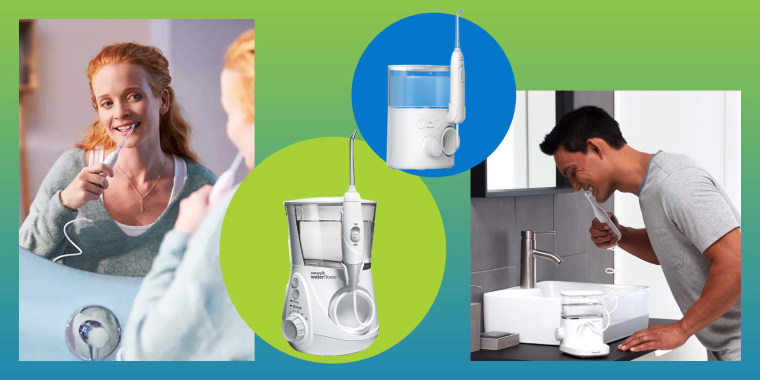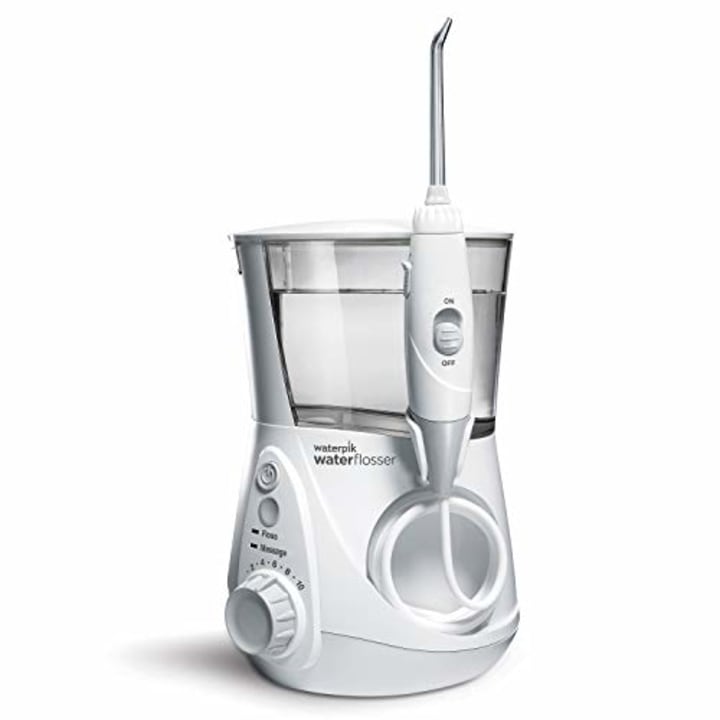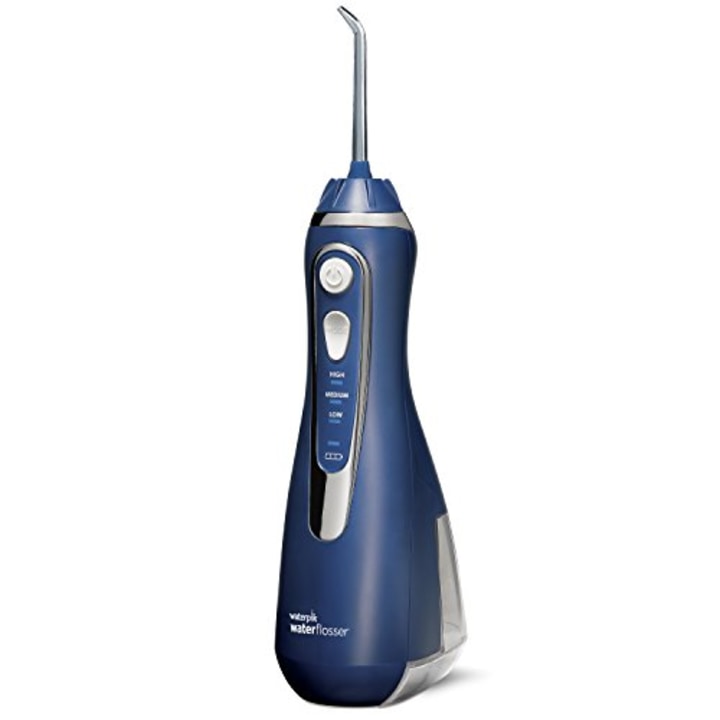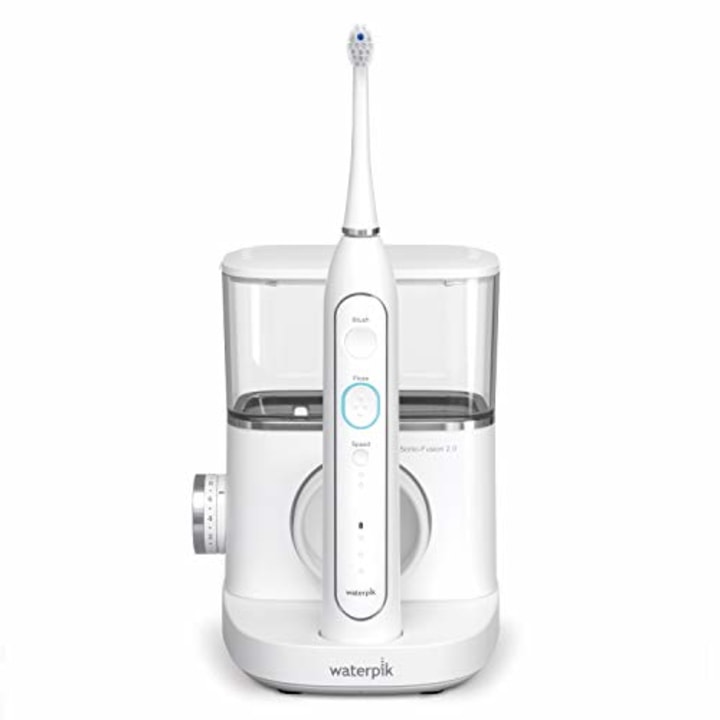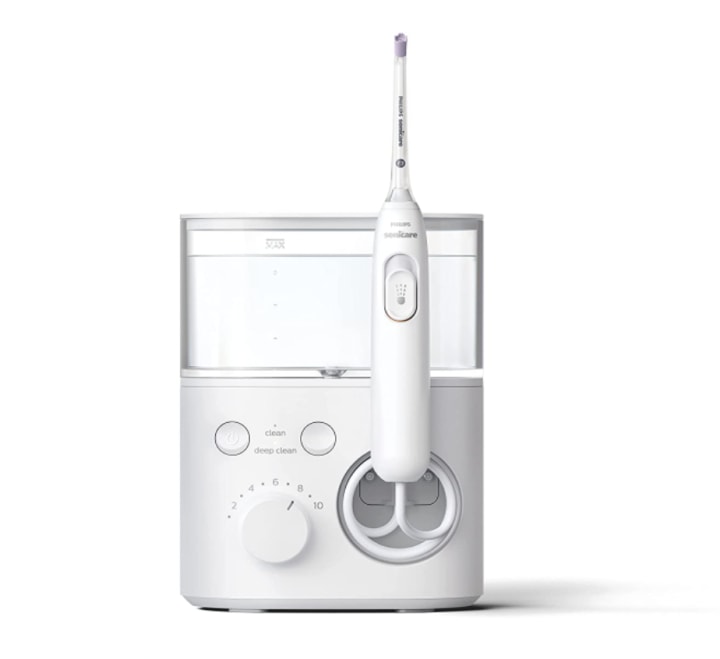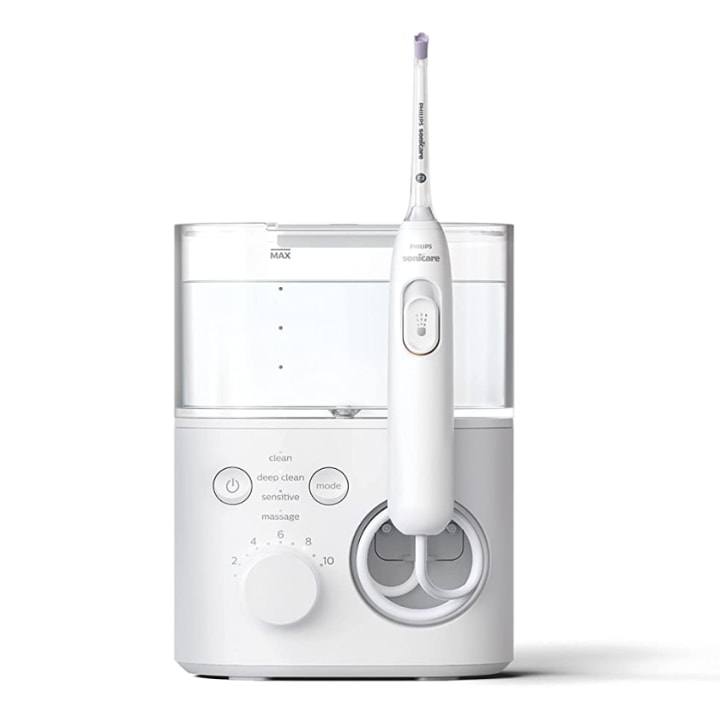Standing in front of the mirror and maneuvering a thin thread of floss between your teeth is not a pleasant task. But flossing is an important part of any oral hygiene routine, in addition to brushing your teeth twice a day with an electric toothbrush or manual toothbrush, as well as toothpaste — it removes plaque, a sticky film made of bacteria that coats your teeth and can cause cavities and eventual tooth decay. Luckily, dental floss is not your only option. Water flossers are an alternative to traditional dental floss that some may find easier (and more enjoyable) to use.
SKIP AHEAD Waterpik water flossers | Philips Sonicare water flossers | Are water flossers effective?
Water flossers are powered handheld devices that shoot pressurized water at the spaces between your teeth through a nozzle (also referred to as a tip by some brands) to target plaque and flush it out, said Dr. Amr Moursi, American Academy of Pediatric Dentistry president-elect and a professor at the NYU College of Dentistry. Most water flossers are designed similarly, so when it comes to shopping for one, experts said to narrow down your options by looking for models that earned the American Dental Association’s Seal of Acceptance. Below, we rounded up ADA-approved water flossers — also called powered interdental cleaners or oral irrigators — and talked to dentists about how to shop for them.
Best water flossers
When it comes to choosing a water flosser, the experts we spoke to recommended choosing products with the ADA Seal of Acceptance. According to the ADA, “a company earns the ADA Seal for floss or other interdental cleaners by producing scientific evidence demonstrating the safety and efficacy of its product in reducing plaque and gingivitis.”
There are dozens of water flossers on the market but currently only a few brands, like Waterpik and Philips Sonicare, have the ADA seal. This does not mean that water flossers without the ADA Seal are ineffective — it just means brands have not submitted their products for the ADA to review, said Dr. Edmond Hewlett, professor at the UCLA School of Dentistry.
Experts told us that most water flossers are built and function similarly. Based on our research, they mainly differ in their water reservoir size, pressure or floss settings (meaning the strength or pulse of the water stream) and the types of nozzles you can attach. These factors can also impact price — the more bells and whistles, the higher the cost.
Waterpik water flossers
Waterpik offers over a dozen ADA-accepted water flossers that range in design — for example, some are battery-operated while others aim to help whiten teeth. Below are four highly rated Waterpik water flossers that range in style and features to give you a sense of what the brand offers.
Waterpik Aquarius Water Flosser Professional
Waterpik’s Aquarius Water Flosser Professional has a 22-ounce water reservoir, enough liquid to fill a tall travel mug, for example, and offers 10 pressure settings. It’s available in colors like orchid, gray, black and more. The water flosser comes with seven different tips (you can buy additional replacements online) that rotate 360 degrees to clean different parts of your teeth.. The Aquarius Water Flosser Professional has a 4.7-star average rating from over 111,300 reviews on Amazon.
Waterpik Cordless Advanced Water Flosser
This Waterpik’s 7-ounce water reservoir is built into this cordless device’s wand. The water flosser offers three pressure settings and 4 tip accessories, which you can individually store in the included travel bag. The charger magnetically attaches to the water flosser itself and charges the device in four hours, according to the brand. It’s available in colors like blue, white, rose gold and more. The Waterpik Cordless Advanced Water Flosser has a 4.5-star average rating from over 48,700 reviews on Amazon.
Waterpik Sonic-Fusion 2.0 Professional Flossing Toothbrush
The Waterpik Sonic-Fusion 2.0 Professional — available in white and black — is a water flosser and a rechargeable electric toothbrush in one. You can use the water flosser and toothbrush together or separately, and the device has 10 water pressure settings as well as two bristle speeds. The Sonic-Fusion 2.0 comes with different brush heads that you can store in the included travel case. It’s built with a 16-ounce water reservoir and it has a 4.5-star average rating from over 11,500 reviews on Amazon.
Waterpik Professional Whitening Water Flosser
Waterpik’s Whitening Water Flosser is designed with what the brand calls “whitening infuser technology.” After you add a whitening tablet to a section built into the water flosser’s handle, it dissolves into water that you shoot at your teeth. The water flosser comes with different tips that rotate 360 degrees and a tip storage case. It offers both floss and massage modes (which emit different pulses of water), as well as 10 pressure settings. The water flosser has a 22-ounce water reservoir and a 4.7-star average rating from over 5,300 reviews on Amazon.
Philips Sonicare water flossers
Three Philips Sonicare water flossers have the ADA Seal: the 3000, 5000 and 7000 models. All three are designed to be quiet while you’re using them, Philips Sonicare said, and utilize the brand’s Quad Stream technology, which distributes water streams in an x-shape over teeth. Philips Sonicare said this helps the flosser cover more surface area while you’re using it. The water flossers are also equipped with the brand’s Pulse Wave technology, meaning pulses of water, rather than a continuous stream, shoot out of the nozzle to help guide you from tooth to tooth while using the device. Below are details about each ADA- accepted Philips Sonicare water flosser.
Philips Sonicare Power Flosser 3000
This water flosser offers two flossing modes — clean and deep clean+ — and 10 water pressure intensities. It comes with two nozzles (you can buy replacements online) and its water reservoir has a 18.6-ounce capacity. The water flosser has a 4.4-star average rating from over 260 reviews on Amazon.
Philips Sonicare Power Flosser 5000
The Philips Sonicare Power Flosser 5000 builds off the 3000 model — it has the same size water reservoir and has two flossing modes, 10 water pressure intensity options and comes with two nozzles. But what makes the 5000 model distinct from the 3000 model is that it’s compatible with an included magnetic dock that automatically stops water from flowing through the nozzle once you reconnect the wand. The water flosser has a 4.4-star average rating from over 400 reviews on Amazon.
Philips Sonicare Power Flosser 7000
The 7000 model is Philip Sonicare’s most advanced water flosser. You can choose from four flossing modes — clean, deep clean, sensitive and massage — and its water reservoir has a 20.3-ounce capacity. The water flosser offers 10 water pressure intensities like the other two models and comes with the same auto shutoff magnetic dock as the 5000 model. The water flosser is sold with three nozzles and a nozzle case, too. It has a 4.5-star average rating from over 260 reviews on Amazon.
How do water flossers work?
The pressurized water that water flossers shoot at teeth is meant to disrupt plaque, flushing it out and helping keep gum tissue healthy. Hewlett told us that though research on these devices is limited, the data that has been collected shows that flossers seem to be effective.
Water flossers, usually shaped like a wand or electric toothbrush, shoot pressurized water between your teeth, essentially flossing them without the effort. Water flossers are all built with water reservoirs that can vary in size, but functionally do the same thing: hold water that will eventually be dispensed from a nozzle at the head of the device. To use the water flosser, you aim the pressurized water at your gum line and lean over the sink with your mouth slightly open to let the water drip out.
Many water flossers come with a variety of nozzles to target specific needs. For example, Waterpik offers an Orthodontic Tip made for those with braces. Additionally, some water flossers need to be plugged in while you’re using them, while others are cordless and built with rechargeable batteries.
Are water flossers effective?
As far as efficacy is concerned, Hewlett said water flossers are useful for anyone looking for an alternative to traditional dental floss. But they’re particularly helpful for those with dental work like braces, bridges, crowns and dental implants. Dental work can make it difficult — and sometimes impossible — to slip traditional dental floss between teeth. Plus, Hewlett noted, water flossers can help you better target plaque between and on the sides of teeth from different angles, which is crucial to good dental health.
Moursi said water flossers may also be a good option for those with mobility issues or conditions like arthritis — floss and floss picks are very small and can be hard to grip for some people, while water flossers have a much larger handle.
However, water flossers pose a few challenges you should be aware of before buying one. Compared to dental floss, they’re larger in size (taking up more counter space in your bathroom) and need to be plugged in while or charged before using them. This means they’re not as portable as dental floss. Water flossers can be messy, too — you have to let the water drip out of your mouth and into the sink while using them, which may get surfaces in your bathroom wet.
Dental floss vs water flossers
Dental floss is considered the gold standard as far as plaque-removing tools go, mainly because it’s been around the longest, said Hewlett. Moursi also added that the benefits of flossing are clear: Multiple research studies indicate its effectiveness in removing plaque from teeth.
Water flossers and other products like floss picks and interdental cleaners don’t have as much research behind their efficacy, but they achieve the same goal: to help remove plaque from teeth. If plaque is not removed through flossing and regular brushing, it can turn into tartar and may also lead to a host of issues including gingivitis (early gum disease), according to the ADA. Because of that, it’s important to use some type of plaque-removal tool daily.
“Something is better than nothing,” Moursi said. “Floss only works if you’re going to use it.”
In order for water flossers to be effective, keep in mind that “you have to hold them in the right position, at the right angle and for the right amount of time,” Moursi said. Experts suggested reading the device’s instructions carefully, watching videos online to learn how to properly use it or asking your dentist for some pointers.
When and how often to use water flossers
Regardless of the tool you use, experts recommend that adults floss once a day. Kids are a different story — Moursi said kids' teeth are less susceptible to plaque, so flossing is less crucial until about age 10, when children’s teeth start growing in more tightly.
There’s no wrong time of day to floss, but experts suggest flossing before bed. Cleaning your teeth at night allows you to remove any grime that builds up during the day. Also, when you’re sleeping, your salivary flow — the body’s natural anti-plaque agent — is at its lowest point, according to Moursi. “Our defense is at its lowest, so when plaque is sitting there overnight, that’s when it can have its greatest impact,” he said. And no, it doesn’t matter whether you floss before or after you brush your teeth. Just that you remember to floss at all.
Catch up on Select's in-depth coverage of personal finance, tech and tools, wellness and more, and follow us on Facebook, Instagram and Twitter to stay up to date.
